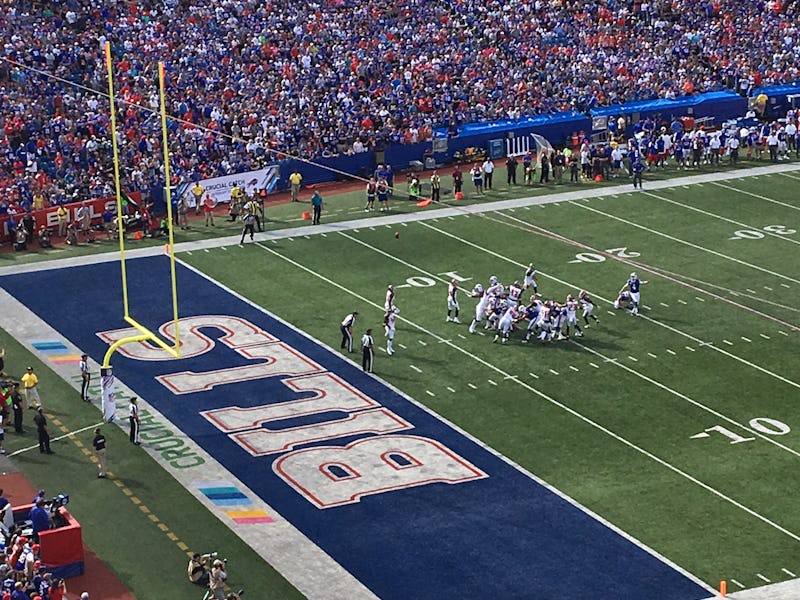Retired NFL and NHL Players' Brains Show Counterintuitive Results in New Study
But this is far from the last word on the matter.

New studies on retired Buffalo Bills and Buffalo Sabres players suggest that chronic traumatic encephalopathy may not be as common in football and hockey players as previously suspected, but due to some serious limitations in the studies’ data and funding, these findings may not be much stronger than any others. In November 2017, doctors who examined 27-year-old football player Aaron Hernandez after his death revealed that he had the worst case of CTE seen in someone that young. And in July 2017, the same team of doctors found that 110 of 111 brains from deceased NFL players showed signs of CTE. These stories, combined with research by the scientists who established a molecular link between traumatic brain injury and CTE, propelled CTE into public consciousness, but new research complicates the picture.
In a set of four papers published August 7 in the Journal of Head Trauma Rehabilitation, a team of researchers at the University of Buffalo found that a small sample of 21 retired professional contact-sport athletes did not show any signs of early-onset dementia, nor did they show any significantly different results in imaging, cognition, behavior, or executive function than a group of similarly aged athletes who didn’t play contact sports. This finding runs counter to the public perception brought on over the last few years by various teams of researchers examining the brains and cognitive functions of professional athletes in high-risk sports like football, boxing, and hockey.
But it’s not a final answer, just one more dimension of the picture.
Researchers ran a number of tests on retied Buffalo Bills and Buffalo Sabres players to see whether they showed signs of CTE.
In one paper, a case-control study of 21 retired professional football and hockey players, researchers used a battery of tests to identify mild cognitive impairment. Compared to an age-matched group of non-contact athletes — bicyclists and runners — the players in question had worse scores on the tests, but their results weren’t significantly higher.
In another paper, researchers examined the same groups of contact and non-contact athletes with MRIs. They did not find any significant differences in either structure or function between the two groups.
In a third paper, researchers conducted a variety of tests on the two groups to investigate differences in executive functioning, the cognitive abilities associated with problem-solving and decision-making. And once again, they found similar levels of performance between the two groups of athletes.
The fourth paper summarized the results of the other three. “None of the retired contact sport athletes qualified as having early-onset dementia consistent with chronic traumatic encephalopathy,” write the studies’ authors. “There were no remarkable differences in imaging, cognition, behavior, or executive function from non-contact sport athletes.”
This graphic shows the classic features of CTE in the brain of Aaron Hernandez. He died by suicide in 2017 after convicted of a murder charge. His case helped rocket CTE to public consciousness.
When compared to other, recent studies that examined the effects of contact sports on players’ long-term brain health, these latest papers, which were funded by the National Institutes of Health, the Ralph and Mary Wilson Foundation, and the Robert Rich Family Foundation, seem to run wildly counter to what one would expect. The authors note that their results could serve to temper public perceptions about CTE being an inevitable part of football and hockey. Whereas the Boston University study showing CTE in 110 out of 111 players was conducted on the donated brains of deceased players, those were people who most likely exhibited worrisome symptoms while they were alive. The subjects of the new research, on the other hand, did express some concerns about their own mental states but didn’t exhibit clear signs of deterioration. Therefore, the study’s authors note, this sample population may be more representative of the average athlete.
But a sample size of 21 is very small. It’s so small, in fact, that it’s really hard to draw any kind of real conclusions about the broader population of retired professional athletes, so these latest results should be taken with a grain of salt.
And given the potential conflicts of interest posed by two of the study’s funding sources — Ralph Wilson owned the Buffalo Bills until his death in 2014, and Rich was once an owner of the Sabres — it’s much too soon to say that this study settles the issue. While funding sources don’t necessarily invalidate a study’s findings, they do raise questions. So yes, these results do add some dimensions to the picture of CTE in athletes, but they’re far from providing the last word.